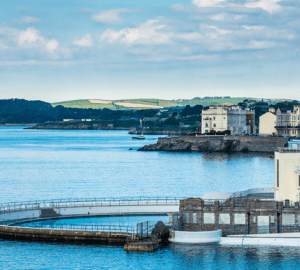Saving Lives
Andy Butterfield talks about his work as an RNLI volunteer, staying safe in the water and his enjoyment of open water swimming
The Royal National Lifeboat Institution (RNLI) is staffed primarily by volunteers. While its tagline is “The Charity that Saves Lives at Sea”, it also works inland. In fact, its busiest station is Tower, on the Thames at Victoria Embankment in Central London, which receives around 500 call-outs (or shouts) per year. The busiest coastal station is Poole, which receives around 180 shouts per year. Teddington, at the tidal limit of the Thames, had 80 last year.
The nature of the work naturally depends on the location of the station. While we do also get boat-related incidents at Teddington (typically breakdowns or boats running out of fuel), these are far fewer than you would get in a coastal station. On the river, we are often called to alcohol and mental health related incidents. These typically involve jumping or the threat of people jumping from bridges or sometimes people who have gone missing and were last seen ‘heading towards the river’. Unfortunately, we also get too many young men swimming when drunk and then drowning.
Due to alcohol being linked to most incidents we get as a station we have launched a local campaign, in conjunction with the RNLI’s national Respect the Water campaign (see below for more details), to provide throw bags to riverside pubs, bars and businesses in the area. To accompany this, we provide training at least twice a year to ensure the staff know how to use the bags while another charity provides basic first aid training. One member of the security team at the Viper Rooms in Kingston has used his throw bags to save at least four lives since we launched our campaign. The RNLI are now expanding the throw line campaign at eight more pilot locations.
In addition to the throw line campaign a number of our crew also give up their time to travel around local schools educating large numbers of children on the dangers of water, but more importantly on how to enjoy the water safely.
Personally, I have long been interested in why many people who live along the river, including local kids, swim perfectly happily without any problems whereas other people get into difficulties and, sadly, sometimes drown. The main reason appears to be linked to alcohol.
People who have been drinking alcohol are more susceptible to drowning for a number of reasons. For example, they may set unrealistic ambitions such as attempting to swim fully clothed across a fast flowing cold river in the dark. In addition, their physical abilities and coordination will be impaired.
Drowning can occur very quickly. Your average Saturday night reveller is probably unaware of the immediate disabling effects of cold water shock and that it may induce an involuntary gasp while their head is underwater. Swim failure also happens more quickly to people who’ve been drinking.
Peripheral vasoconstriction is a normal bodily defence response that restricts blood flow to the extremities in cold water in order to preserve heat and to maintain the blood and oxygen supply to the vital organs, especially the brain. However, alcohol does the opposite and tends to dilate blood vessels. This has the perverse effect of simultaneously making you feel warmer (as most heat sensors are near the surface of the skin) while actually lowering the temperature of your core, and hence your ability to coordinate your movements and swim.
While I’m not against anyone enjoying the river or a beer, I strongly recommend not swimming while under the influence of alcohol.
The best and worst of it
The worst part of the role of being crew is recovering the bodies of those that, for whatever reason, have passed away in the river. Tragically, with the exception of those with excess alcohol in them, the vast majority of people we recover had intended to die.
The best parts of being volunteer crew include being part of an amazing team of like-minded local people, being trained by the RNLI and the station to an exceptional standard across all relevant areas including boat handling, first aid, radio, local knowledge, environmental effects and more and to have a positive impact on the lives of those who live and work by, and enjoy, the river and riverside.
While I’ve witnessed several tragic accidents my personal enjoyment of open water swimming has not been affected by the work I do. In fact, it has given me the confidence to truly respect the water, and understand what the dangers could be (eg rowers, tides, temperature, etc) so that I can take appropriate action. Understanding your environment is the most important thing you could do before swimming and enabling you to truly enjoy it.
Find out more
General information: rnli.org
Become volunteer crew: https://volunteering.rnli.org/join-the-crew-2051.html
Find your nearest station: rnli.org/findmynearest/Pages/default.aspx
Image: Emma Durnford








